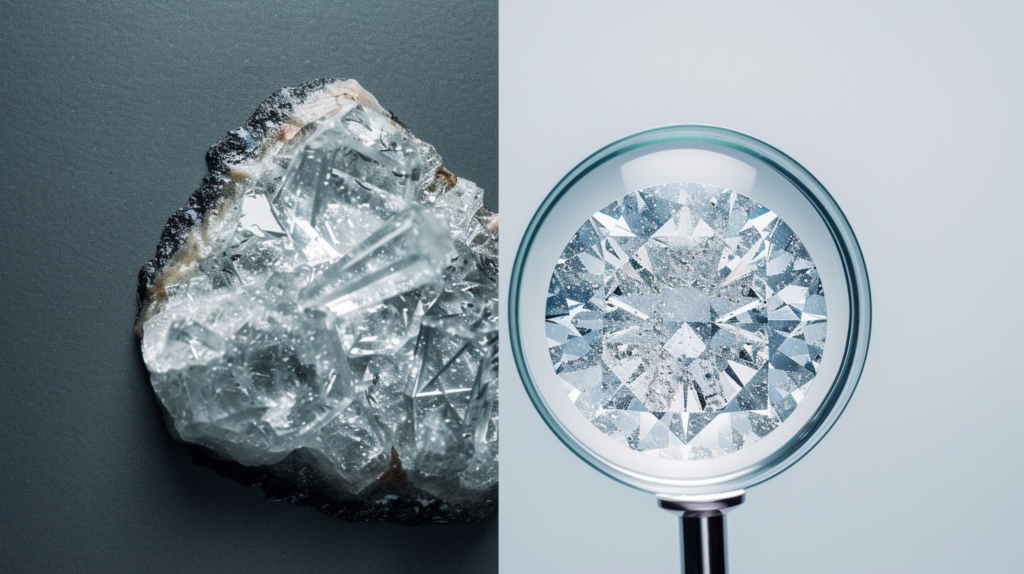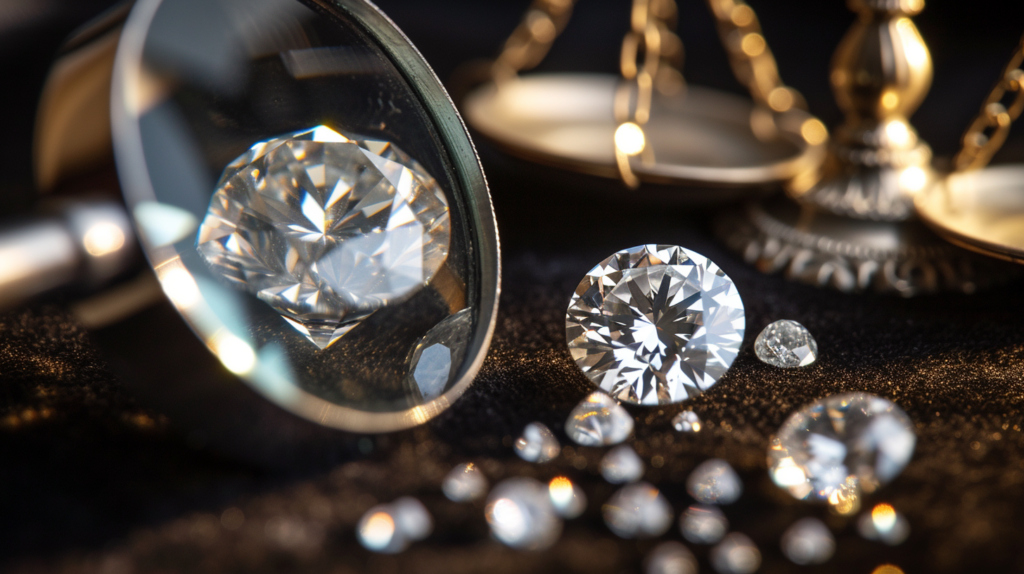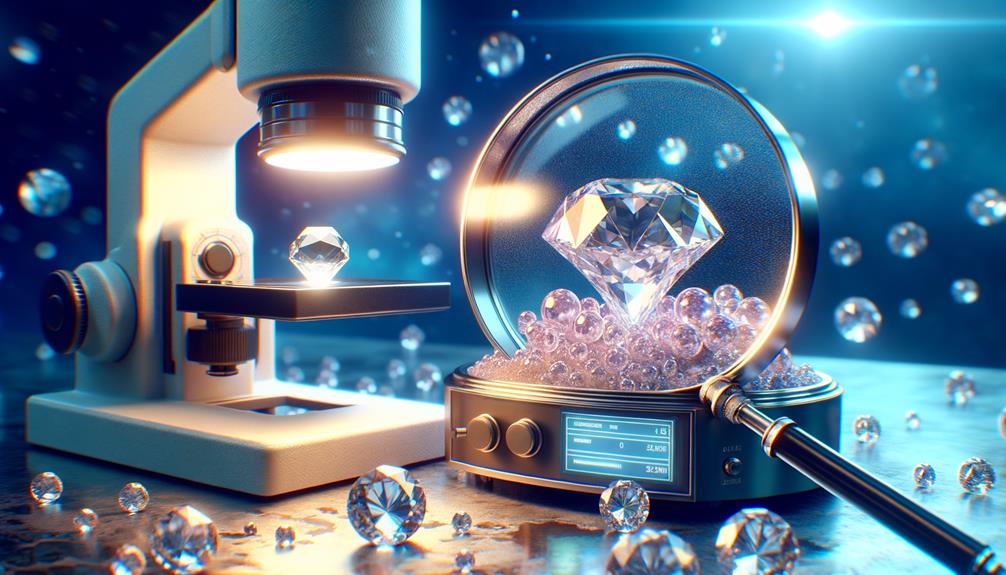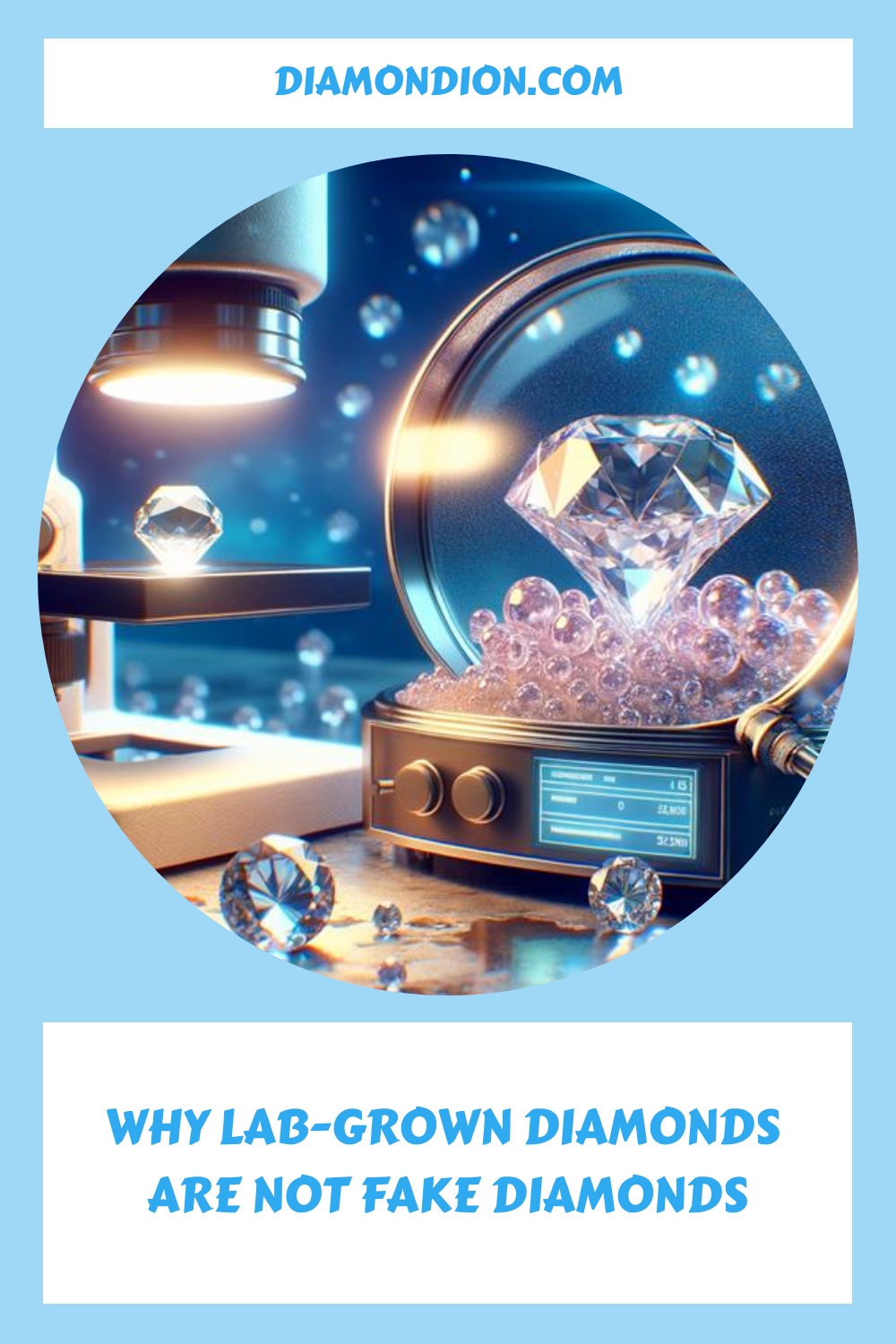Article Contents
- 1 Key Takeaways About Why Lab Diamonds Are Not Fake Diamonds
- 2 Understanding Lab-Grown Diamonds
- 3 Debunking Common Myths
- 4 The Creation Process Explained
- 5 Environmental and Ethical Benefits
- 6 Comparing Lab-Grown and Natural Diamonds
- 7 Making the Right Choice
- 8 Frequently Asked Questions About Lab-Diamonds
- 9 What Makes Lab-Grown Diamonds Different Yet Authentic Compared to Natural Diamonds?
- 10 Further Reading About Why Lab Diamonds Are Not Fake Diamonds
I find it amusing that you came across this topic, a gem, just as lab-grown diamonds dazzle the world. Let’s start out with this, lab diamonds are not fake diamonds!
Here you are, possibly thinking of popping the question or just treating yourself, and bam, the universe throws you into the sparkling debate of lab-grown vs. mined diamonds.
Let’s set the record straight: lab-grown diamonds aren’t your grandma’s cubic zirconia; they’re the real McCoy, chemically identical to their earth-dug siblings but without the baggage of environmental and ethical woes.
These high-tech marvels are not just for sci-fi aficionados but for anyone with a taste for luxury without the guilt trip.
So, if the idea of flaunting a stone that is as kind to the environment as it is to your wallet intrigues you, stay tuned. There’s more to uncover about these glittering symbols of the future that might change your view on what it means to sparkle responsibly.
Key Takeaways About Why Lab Diamonds Are Not Fake Diamonds
- Lab-grown diamonds are considered the ethical alternative to traditional mined diamonds.
- Lab-grown diamonds have the same chemical and physical properties as mined diamonds.
- Lab-grown diamonds offer a more affordable option compared to mined diamonds.
- Lab-grown diamonds are visually indistinguishable from natural diamonds.
Understanding Lab-Grown Diamonds
Diving into the world of lab-grown diamonds is like finding an ethical treasure trove that sparkles just as brightly as its earth-dug counterpart without the hefty price tag or eco-guilt. You’re not just snagging a gem; you’re joining a growing tribe of trendsetters who know a good thing when they see it. So, let’s dish the dirt—or lack thereof—on these sparkly stones.
First of all, market demand is soaring faster than a rocket. Why? Because you, the savvy consumer, have caught on to the secret. You’re all about that sparkle without the scandal, and lab-grown diamonds deliver. They’re like the cool, ethical cousin of the traditional diamond.
Now, let’s talk about consumer perception. It’s shifting faster than fashion trends. With gemological certification in hand, these diamonds are proving they’re not just real; they’re spectacular. They’ve got the creds to prove it, folks.
Price comparison? It’s a no-brainer. You’re getting the biggest bang for your buck, allowing you to flaunt that bling without draining your bank account.
And industry growth? It’s on fire. As acceptance grows, so does innovation, making lab-grown diamonds the must-have gem of the future. Welcome to the club—we’ve been expecting you.

Debunking Common Myths
Now that we’ve got your attention with the glittering prospects of lab-grown diamonds, let’s bust some myths that are as outdated as flip phones.
First off, ditch the idea that lab-grown diamonds are the cubic zirconias of the gem world. That’s like comparing a designer bag to a knockoff; they’re just not the same. Misconceptions clarified: these sparklers have the same chemical and physical oomph as their earth-dug counterparts.
To dispel doubts further, remember that lab-grown diamonds aren’t just for science geeks. They’re conflict-free, making you a hero for choosing ethical bling. You’re not just saving the planet; you’re also saving some serious cash.
Common misconceptions like ‘they must look different’ couldn’t be more wrong. If anything, they’re like the twins of natural diamonds—visually indistinguishable.
Separating fact from fiction, let’s not forget that reputable institutions like the GIA give them the nod of approval. They’re real, certified, and graded. Demystifying lab-grown diamonds isn’t rocket science; it’s simply realizing that these gems are a modern marvel.
Welcome to the sparkling future, where your diamond doesn’t come with a side of guilt.
The Creation Process Explained
Peeking behind the curtain of lab-grown diamonds, you’ll find their creation process is more sci-fi chic than mad scientist. Imagine donning a lab coat and goggles—not to mix volatile chemicals but to craft the bling of the future. The creation process isn’t just about pressing a ‘make diamond’ button. It’s an artful blend of science and style, where growth techniques meet diamond synthesis in a dazzling dance. Additionally, the art of diamond formation in the lab involves recreating the extreme pressure and heat that natural diamonds experience deep within the earth. This requires cutting-edge technology and precise control over factors such as temperature, pressure, and carbon input. The result is a mesmerizing display of human ingenuity, producing diamonds that are not only beautiful, but also ethical and sustainable.
Diving into the nitty-gritty, you’ve got two main headliners: Chemical Vapor Deposition (CVD) and High Pressure High Temperature (HPHT). With CVD, think of it as nurturing a diamond from a cloud of gas—very celestial. The diamond slowly crystallizes, layer by layer, in a high-tech chamber that wouldn’t look out of place in a spaceship.
Switch gears to HPHT, and it’s like recreating the Earth’s crust in a lab. Massive pressure and heat transform the carbon into a sparkling diamond, mimicking nature’s own method but without the billion-year wait time.
Environmental and Ethical Benefits
After exploring lab-grown diamonds’ sci-fi chic creation process, let’s shift gears and spotlight the real superstars: their environmental and ethical benefits. You’re not just bagging a sparkler; you’re embracing Mother Earth and giving a high-five to ethical practices. Feeling good yet? You should be, and here’s why:
- Sustainable sourcing & Responsible consumption
- Less is more: Lab-grown diamonds need less land, water, and energy. Say goodbye to deforestation and habitat destruction. It’s like your diamond comes with a cape, ready to save the planet.
- Ethical practices: With no dark clouds of conflict or unethical labour practices, your diamond shines brighter. You’re not just wearing a gem; you’re wearing your values.
- Environmental impact & Budget-friendly options
- Green for the win: Lower environmental impact means you’re part of the solution, not the problem. Your diamond doesn’t come at Earth’s expense.
- Save that cash: Who said being ethical and eco-conscious couldn’t be budget-friendly? With lab-grown diamonds, you get the bling without breaking the bank.
Comparing Lab-Grown and Natural Diamonds
When diving into the glittery world of diamonds, it’s essential to remember that not all sparkles are mined; some are born in labs, offering a wallet-friendly and earth-loving alternative. Let’s break it down, shall we?
On the pricing front, lab-grown diamonds are the savvy shopper’s BFF. They’re like the designer dupes of the diamond world—same sparkle, less dough. And when it comes to quality, these lab-born beauties are no second fiddles. They can be optimized for fewer blemishes, making them the clear choice for those who like their bling flawless.
Now, let’s chat about consumer perceptions. Some folks might still raise an eyebrow at lab-grown diamonds, but let’s be real: as we become more eco-conscious, these gems are quickly becoming the cool kids on the block. The sustainability bragging rights? Unparalleled. Opting for a lab-grown diamond means you’re saying ‘peace out’ to the environmental and ethical nightmares of traditional diamond mining.
Making the Right Choice

Deciding between lab-grown and natural diamonds isn’t just about bling; it’s a savvy move towards sustainability and ethics, sprinkled with a dash of wallet wisdom. You’re not just picking a sparkly stone; you’re making a statement about what matters to you. Let’s break it down:
- Pricing considerations
- Lab-grown diamonds? More bang for your buck. You’re essentially getting the VIP experience without the VIP price tag.
- Consumer awareness
- Be the trendsetter in your circle. Flaunt your knowledge about the eco-friendliness and ethical sourcing of lab-grown diamonds.
Nested within these considerations are two vital aspects you can’t overlook:
- Unique designs and Personal preference
- *Unique designs:* Stand out from the crowd with a gem that’s as unique as your Netflix watchlist.
- *Personal preference:* Whether you’re about that minimalist vibe or full-on glamour, there’s a lab-grown diamond that’s just your style.
- Appraisal and insurance
- Just like your favourite vintage sneaks, get your gem appraised and insured. Because you never know when you’ll need that backup.
Choosing a lab-grown diamond isn’t just smart; it’s a reflection of your values, wrapped in a shiny package of personal flair.
Frequently Asked Questions About Lab-Diamonds
Are Lab-Grown Diamonds Considered Fake?
You’re probably wondering if lab-grown diamonds are the imposters of the gem world, right? Well, they’re not! Thanks to their scientific creation, they’re as real as it gets, with the same sparkle but more ethical sourcing and less environmental impact.
Plus, they’re easier on your wallet. So, as consumer perception shifts, remember that choosing lab-grown means you’re trendy, thoughtful, and savvy.
Embrace them and be part of a sparkling, sustainable future!
Why Are Jewellers Against Lab Diamonds?
Some jewellers might side-eye lab diamonds because they shake up the traditional craftsmanship vibe, messing with market impact and consumer perception. They’re worried about ethical concerns overshadowing their art.
Plus, the price competition? It’s fierce, making their classic gems look pricier. It’s all about keeping their sparkle in a world where lab diamonds are the cool, ethical alternative.
They’re just trying to fit in while sticking to their roots.
Can a Jeweller Tell a Lab-Grown Diamond?
Yes, a jeweller can often tell a lab-grown diamond, but it’s not always easy. With the right equipment upgrades and professional training, they’re getting better at identification techniques. In the past, it was much easier to spot the differences between mined and lab-grown diamonds, but as technology and techniques continue to advance, the distinctions are becoming more subtle. Despite this, there are still some key factors that differentiate the two, such as the lack of inclusions in lab-grown diamonds and the absence of natural growth patterns. However, with ongoing advancements in the industry, it’s important for jewellers to stay up to date with the latest developments in identifying mined vs labgrown diamonds.
It’s all about grading accuracy and market adaptation, folks. Jewellers have had to up their game as lab diamonds become trendier.
Why Do Lab-Grown Diamonds Not Test as Real?
You’re thinking lab-grown diamonds don’t test as real because of their origins, right? Well, it’s all about the testing methods focusing on chemical composition and reflective properties.
Despite being identical twins in the gem world, some tests still side-eye them. But here’s the kicker: with proper certification processes, they’re proving their worth.
It’s time to shift the market perception and embrace these sparkly marvels. They’re legit, just like your desire to fit in and shine.
What Makes Lab-Grown Diamonds Different Yet Authentic Compared to Natural Diamonds?
Lab-grown diamonds share the same visual brilliance and chemical composition as their natural counterparts but originate in advanced labs instead of deep within the Earth. This makes them eco-friendly and conflict-free, offering ethical elegance. The debate of labcreated vs natural diamonds highlights preference, yet both hold unmatched beauty and value.
Further Reading About Why Lab Diamonds Are Not Fake Diamonds
1: https://www.koserjewelers.com/blog-post/pros-and-cons-of-lab-grown-diamonds
2: https://frankdarling.com/blog/7-reasons-not-to-buy-a-lab-grown-diamond/
3: https://www.gemsociety.org/article/lab-grown-diamonds-faq/
4: https://www.nathanalanjewelers.com/lab-diamonds-vs-natural-diamonds
5: https://www.forbes.com/sites/pamdanziger/2021/02/14/lab-grown-or-natural-diamonds-the-choice-is-getting-clearer-for-consumers-and-retailers/



